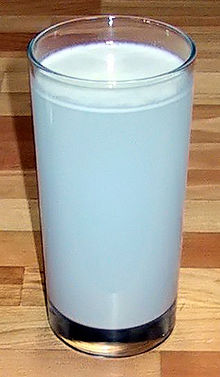Mixture: Difference between revisions
No edit summary |
No edit summary |
||
| Line 3: | Line 3: | ||
[[Image:WaterAndFlourSuspensionLiquid.jpg|thumb|A [[suspension (chemistry)|suspension]] of flour in water, a heterogeneous mixture]] |
[[Image:WaterAndFlourSuspensionLiquid.jpg|thumb|A [[suspension (chemistry)|suspension]] of flour in water, a heterogeneous mixture]] |
||
In [[chemistry]], a '''mixture''' is a material system made up by two or more different [[chemical substance|substances]] which are ([[mix]]ed) together but are not combined chemically. The molecules of two or more different substances are mixed in the form of [[alloy|alloys]], [[solutions]], [[suspensions]], and [[colloids]]. |
In [[chemistry]], a '''mixture''' is a material system made up by two or more different [[chemical substance|substances]] which are ([[mix]]ed) together but are not combined chemically. Mixture refers to the physical combination of two or more substances the identities of which are retained. The molecules of two or more different substances are mixed in the form of [[alloy|alloys]], [[solutions]], [[suspensions]], and [[colloids]]. |
||
Mixtures are the product of a [[wikt:blend|mechanical blending]] or mixing of [[chemical substance]]s like [[chemical element|elements]] and [[chemical compound|compounds]], without chemical bonding or other chemical change, so that each ingredient substance retains its own chemical properties and makeup.<ref>Atkins' Physical Chemistry, 7th Ed. by Julio De Paula, P.W. Atkins ISBN 0198792859</ref> Nonetheless, despite there are no chemical changes to its constituents, the physical properties of a mixture, such as its [[melting point]], may differ from those of the components. Some mixtures can be [[separation process|separated]] into their components by mechanical means; [[azeotrope]]s cannot, at least not directly. |
Mixtures are the product of a [[wikt:blend|mechanical blending]] or mixing of [[chemical substance]]s like [[chemical element|elements]] and [[chemical compound|compounds]], without chemical bonding or other chemical change, so that each ingredient substance retains its own chemical properties and makeup.<ref>Atkins' Physical Chemistry, 7th Ed. by Julio De Paula, P.W. Atkins ISBN 0198792859</ref> Nonetheless, despite there are no chemical changes to its constituents, the physical properties of a mixture, such as its [[melting point]], may differ from those of the components. Some mixtures can be [[separation process|separated]] into their components by mechanical means; [[azeotrope]]s cannot, at least not directly. |
||
Mixtures can be either [[homogeneous (chemistry)|homogeneous]] or [[heterogeneous]]. A homogeneous mixture is a type of mixture in which the composition is uniform. A heterogeneous mixture is a type of mixture in which the composition can easily be identified, as there are two or more phases present. Air is a homogeneous mixture of the gaseous substances nitrogen, oxygen, and smaller amounts of other substances. Salt, sugar, and many other substances dissolve in water to form homogeneous mixtures. A homogeneous mixture in which there is both a [[solute]] and [[solvent]] present is also a solution. |
|||
==Types of mixtures== |
==Types of mixtures== |
||
Revision as of 14:54, 4 July 2010

In chemistry, a mixture is a material system made up by two or more different substances which are (mixed) together but are not combined chemically. Mixture refers to the physical combination of two or more substances the identities of which are retained. The molecules of two or more different substances are mixed in the form of alloys, solutions, suspensions, and colloids.
Mixtures are the product of a mechanical blending or mixing of chemical substances like elements and compounds, without chemical bonding or other chemical change, so that each ingredient substance retains its own chemical properties and makeup.[1] Nonetheless, despite there are no chemical changes to its constituents, the physical properties of a mixture, such as its melting point, may differ from those of the components. Some mixtures can be separated into their components by mechanical means; azeotropes cannot, at least not directly.
Mixtures can be either homogeneous or heterogeneous. A homogeneous mixture is a type of mixture in which the composition is uniform. A heterogeneous mixture is a type of mixture in which the composition can easily be identified, as there are two or more phases present. Air is a homogeneous mixture of the gaseous substances nitrogen, oxygen, and smaller amounts of other substances. Salt, sugar, and many other substances dissolve in water to form homogeneous mixtures. A homogeneous mixture in which there is both a solute and solvent present is also a solution.
Types of mixtures
| Dissolved or dispersed phase | Continuous medium | Solution: Homogeneous mixture: Dissolved phase < 1 nanometer | Colloid: Dispersed phase between 1 nanometer and 1 micrometer | Dispersion: Heterogeneous mixture: Dispersed phase > 1 micrometer |
|---|---|---|---|---|
| Gas | Gas | Gas mixture: air (oxygen and other gases in nitrogen) | None | None |
| Liquid | Gas | None | Aerosol: fog, mist, vapor, hair sprays | Aerosol |
| Solid | Gas | None | Solid aerosol: smoke, cloud, air particulates | Solid aerosol: dust |
| Gas | Liquid | Solution: oxygen in water | Foam: whipped cream, shaving cream | Foam |
| Liquid | Liquid | Solution: alcoholic beverages | Emulsion: miniemulsion, microemulsion | Emulsion: milk, mayonnaise, hand cream |
| Solid | Liquid | Solution: sugar in water | Sol: pigmented ink, blood | Suspension: mud (soil, clay or silt particles are suspended in water), chalk powder suspended in water |
| Gas | Solid | Solution: hydrogen in metals | Solid foam: aerogel, styrofoam, pumice | Foam: dry sponge |
| Liquid | Solid | Solution: amalgam (mercury in gold), hexane in paraffin wax | Gel: agar, gelatin, silicagel, opal | Wet sponge |
| Solid | Solid | Solution: alloys, plasticizers in plastics | Solid sol: cranberry glass | Gravel, granite |
References
- ^ Atkins' Physical Chemistry, 7th Ed. by Julio De Paula, P.W. Atkins ISBN 0198792859
IUPAC, Compendium of Chemical Terminology, 2nd ed. (the "Gold Book") (1997). Online corrected version: (2006–) "mixture". doi:10.1351/goldbook.M03949
